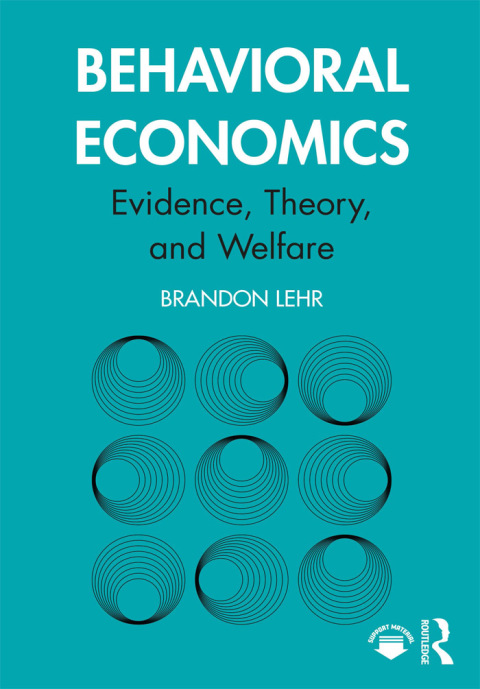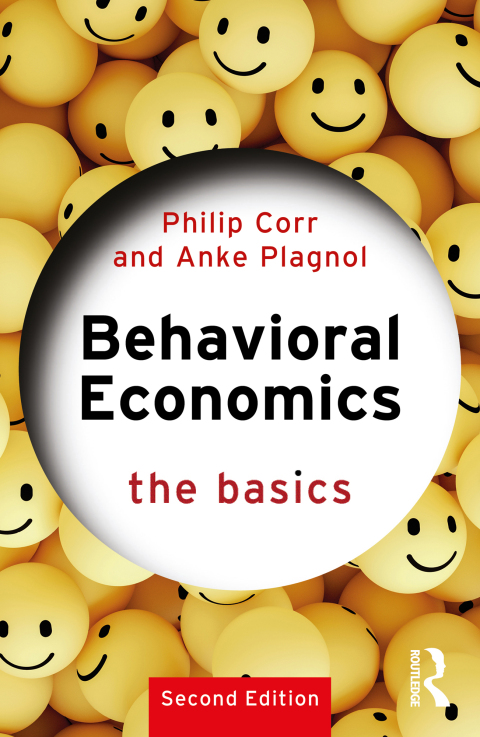Description
Efnisyfirlit
- Cover Page
- Half Title Page
- Title Page
- Copyright Page
- Dedication Page
- Table of Contents Page
- Empirical Evidence from the Field, by Topic Page
- Note to Instructors Page
- Acknowledgements Page
- Part I Foundations
- 1 Introduction
- 1.1 Why Study Behavioral Economics?
- 1.2 Why Behavioral Economics Now? A Brief History
- 1.3 A Roadmap for the Book
- 1.3.1 Structure
- 1.3.2 Topics
- 1.4 Empirical Methods
- 1.4.1 Testing an Economic Theory
- 1.4.2 Identifying Causality
- 1.4.3 Experimental Data
- 1.5 Summary
- References
- 2 Standard Decision Making
- 2.1 The Decision Problem
- 2.2 Decision Making Over Time
- 2.2.1 Time Discounting
- 2.2.2 Constant Discounting
- 2.2.3 Time Consistency
- 2.3 Decision Making with Uncertainty
- 2.3.1 Describing Uncertainty
- 2.3.2 Evaluating Uncertainty
- 2.3.3 Risk Preferences
- 2.3.4 The Expected Utility Model
- 2.4 Standard Model of Individual Decision Making
- 2.5 Rational Behavior
- 2.6 Summary
- 2.7 Exercises
- References
- 3 Behavioral Welfare Economics
- 3.1 Welfarism
- 3.2 Welfare of Standard Decision Making
- 3.3 Internalities
- 3.3.1 Welfare Loss of an Internality
- 3.3.2 Paternalistic Taxation
- 3.4 Nudges
- 3.4.1 Defining Nudges
- 3.4.2 How Nudges Work
- 3.4.3 Advantages of Nudging
- 3.4.4 Disadvantages of Nudging
- 3.5 Health Mistakes
- 3.5.1 Choosing Health Care
- 3.5.2 Choosing Health Insurance Plans
- 3.6 Energy-Efficient Light Bulb Underuse
- 3.7 Summary
- 3.8 Exercises
- References
- Part II Intertemporal Preferences
- 4 Discounted Utility Model Anomalies
- 4.1 Time Effects
- 4.1.1 Preference Reversals
- 4.1.2 Hyperbolic Discounting
- 4.1.3 Poverty and Discounting
- 4.2 Magnitude Effect
- 4.3 Sign Effect
- 4.4 Preference for Improving Sequences
- 4.5 Life-Cycle Model
- 4.5.1 Preferences
- 4.5.2 Budget Constraint
- 4.5.3 The Solution
- 4.5.4 Implications
- 4.5.5 Life-Cycle Evidence
- 4.6 Summary
- 4.7 Exercises
- 4A Appendix: The Calculus of the Life-Cycle Model
- 4A.1 Appendix Summary
- 4A.2 Appendix Exercises
- References
- 5 Present Bias
- 5.1 Present-Biased Preferences
- 5.1.1 Quasi-Hyperbolic Discounting
- 5.1.2 Time Inconsistency
- 5.1.3 Welfare with Present Bias
- 5.2 Consumption of a Good
- 5.3 Doing it Once
- 5.3.1 Model Setup
- 5.3.2 Examples
- 5.3.3 General Results
- 5.3.4 Welfare
- 5.4 Empirical Evidence of Present Bias
- 5.4.1 Exercise
- 5.4.2 School Work
- 5.4.3 Present-Biased Life-Cycle Evidence
- 5.4.4 Credit Card Take-Up
- 5.5 Summary
- 5.6 Exercises
- 5A Appendix: The Calculus of the Present-Biased Life-Cycle Model
- 5A.1 Appendix Summary
- 5A.2 Appendix Exercises
- References
- 6 Consumption Dependence
- 6.1 Habit Formation
- 6.2 Drug Use
- 6.3 Empirical Evidence of Habit Formation
- 6.3.1 Voting Habits
- 6.3.2 Tobacco
- 6.4 Anticipation
- 6.5 Anticipation Explanations of Anomalies
- 6.5.1 Sign Effect
- 6.5.2 Timing of Outcomes
- 6.6 Empirical Evidence of Anxiety
- 6.6.1 Avoiding Health Information
- 6.6.2 Stock Market Fluctuations
- 6.7 Summary
- 6.8 Exercises
- References
- 7 Market & Policy Responses to Present Bias
- 7.1 Two-Part Tariffs
- 7.1.1 Pricing for Time-Consistent Consumers
- 7.1.2 Pricing Investment Goods for Present-Biased Consumers
- 7.2 Defaults
- 7.2.1 Suggested Tips
- 7.2.2 Organ Donations
- 7.2.3 Retirement Savings
- 7.3 Nudging and Taxing Sin Goods
- 7.3.1 Welfare with Sin Goods
- 7.3.2 Nudging Dessert
- 7.3.3 Sin Taxes
- 7.4 Summary
- 7.5 Exercises
- References
- Part III Reference-Dependent Preferences
- 8 Reference-Independence Anomalies
- 8.1 Endowment Effect
- 8.1.1 Early Evidence from the Lab
- 8.1.2 Further Evidence from the Field
- 8.2 Coding Lotteries
- 8.2.1 Recoding a Lottery
- 8.2.2 Aversion to Small-Stakes Lotteries
- 8.3 Equity Premium Puzzle
- 8.3.1 Returns and Investments
- 8.3.2 The Equity Premium
- 8.3.3 The Puzzle
- 8.4 Summary
- 8.5 Exercises
- 8A Appendix: The Math of Absurd Lottery Preferences
- References
- 9 Reference Dependence
- 9.1 Reference-Dependent Preferences
- 9.1.1 Gain-Loss Utility
- 9.1.2 A Model of Reference-Dependent Preferences
- 9.2 Application: Endowment Effect
- 9.2.1 Endowment-Based Reference Points
- 9.2.2 Expectations-Based Reference Points
- 9.3 Application: Aversion to Small-Stakes Lotteries
- 9.3.1 Expected Gain-Loss Utility
- 9.3.2 Revisiting Absurd Lottery Preferences
- 9.3.3 Loss Aversion vs. Risk Aversion
- 9.4 Application: Equity Premium Puzzle
- 9.5 Empirical Evidence of Reference Dependence
- 9.5.1 Targeting Income
- 9.5.2 Job Search Effort
- 9.5.3 Life-Cycle Consumption Expectations
- 9.6 Summary
- 9.7 Exercises
- 9A Appendix: The Math of Random Reference Points
- 9A.1 Appendix Exercises
- References
- 10 Market & Policy Responses to Loss Aversion
- 10.1 Welfare Interpretations of Loss Aversion
- 10.2 Reusable Bag Use
- 10.2.1 Background and Evidence
- 10.2.2 Modeling Loss Averse Shoppers
- 10.2.3 Explanations Beyond Loss Aversion
- 10.3 Teacher Compensation
- 10.4 Worker Bonuses
- 10.5 Auctions
- 10.5.1 Auction Types
- 10.5.2 Auction Revenue with Standard Bidders
- 10.5.3 Auction Revenue with Loss Averse Bidders
- 10.6 Summary
- 10.7 Exercises
- References
- Part IV Preferences over Uncertainty
- 11 Expected Utility Anomalies
- 11.1 Anomalies with Objective Probabilities
- 11.1.1 Allais Paradox
- 11.1.2 Reflection Effect
- 11.1.3 Overweighting Unlikely Outcomes
- 11.2 Ellsberg Paradox
- 11.3 Summary
- 11.4 Exercises
- References
- 12 Non-Expected Utility
- 12.1 Prospect Theory
- 12.1.1 Diminishing Sensitivity
- 12.1.2 Probability Weighting
- 12.2 Application: Anomalies with Objective Probabilities
- 12.2.1 Allais Paradox
- 12.2.2 Reflection Effect
- 12.2.3 Overweighting Unlikely Outcomes
- 12.3 Empirical Evidence of Probability Weighting
- 12.3.1 Insurance
- 12.3.2 Lotteries
- 12.4 Maxmin Expected Utility
- 12.5 Application: Ellsberg Paradox
- 12.6 Personal Finance with Ambiguity Aversion
- 12.6.1 The Logic of Ambiguity Aversion
- 12.6.2 Empirical Evidence of Ambiguity Aversion
- 12.7 Summary
- 12.8 Exercises
- References
- Part V Social Preferences
- 13 Self-Interested Preference Anomalies
- 13.1 Giving in the Field
- 13.1.1 Philanthropy
- 13.1.2 Tipping
- 13.2 Giving in the Lab
- 13.2.1 Dictator Game
- 13.2.2 Ultimatum Game
- 13.2.3 Public Good Game
- 13.3 Summary
- 13.4 Exercises
- References
- 14 Social Preferences
- 14.1 Altruism
- 14.1.1 Modeling Altruistic Philanthropy
- 14.1.2 Evaluating Altruistic Philanthropy
- 14.2 Warm-Glow Giving
- 14.3 Distributional Preferences
- 14.3.1 Modeling Distributional Preferences
- 14.3.2 Distributional Preferences in Lab Games
- 14.4 Reciprocity
- 14.4.1 Ultimatum Game
- 14.4.2 Gift Exchange
- 14.5 Social Pressure
- 14.5.1 Modeling Social Pressure
- 14.5.2 Social Pressure in the Field
- 14.5.3 Social Norms
- 14.6 Summary
- 14.7 Exercises
- References
- 15 Market & Policy Responses to Social Preferences
- 15.1 Employers
- 15.1.1 Worker Effort under Pressure
- 15.1.2 Pay Transparency
- 15.2 Unemployment
- 15.3 Optimal Taxation
- 15.3.1 Welfare Interpretations of Social Preferences
- 15.3.2 Three Tax Policies
- 15.4 Social Pressure and Norms as Policy
- 15.4.1 Voting Pressure
- 15.4.2 Tax Collection
- 15.5 Summary
- 15.6 Exercises
- References
- Part VI Beliefs
- 16 Belief Anomalies
- 16.1 Overconfidence
- 16.1.1 Overestimation
- 16.1.2 Overplacement
- 16.1.3 Overprecision
- 16.2 Confirmation Bias
- 16.3 Representativeness
- 16.3.1 Gambler’s Fallacy
- 16.3.2 Extrapolative Beliefs
- 16.3.3 Base-Rate Neglect
- 16.4 Summary
- 16.5 Exercises
- References
- 17 Nonstandard Beliefs
- 17.1 Overconfidence in Business and Finance Decisions
- 17.1.1 Entrepreneurial Entry
- 17.1.2 Managerial Mergers
- 17.1.3 Investor Trading Volume
- 17.2 Nonstandard Belief Updating
- 17.2.1 Law of Small Numbers
- 17.2.2 Base-Rate Neglect
- 17.3 Extrapolative Beliefs in Financial Markets
- 17.3.1 Empirical Facts and Evidence
- 17.3.2 Asset Prices with Extrapolative Beliefs
- 17.4 Summary
- 17.5 Exercises
- References
- 18 Market & Policy Responses to Nonstandard Beliefs
- 18.1 Welfare with Nonstandard Beliefs
- 18.2 Overconfident Employees
- 18.2.1 A Compensation Puzzle
- 18.2.2 Exploitation via Stock Options
- 18.3 Overconfident Consumers
- 18.3.1 Exploitation via Complex Pricing
- 18.3.2 Protection via Public Policy
- 18.4 Social Insurance
- 18.4.1 Optimal Social Insurance
- 18.4.2 Optimal Unemployment Insurance Benefits
- 18.4.3 Optimal Health Insurance Copays
- 18.5 Summary
- 18.6 Exercises
- References
- Part VII Decision Processes
- 19 Mental Accounting
- 19.1 An Introduction to Mental Accounting
- 19.1.1 Examples of Mental Accounting
- 19.1.2 Features of Mental Accounts
- 19.1.3 Mental Accounting in this Chapter
- 19.2 Sunk Costs
- 19.3 Mental Accounting over the Life Cycle
- 19.3.1 A Mental Accounting Life-Cycle Model
- 19.3.2 Income Accounts
- 19.3.3 Wealth Accounts
- 19.4 Excess Diversification
- 19.5 Summary
- 19.6 Exercises
- References
- 20 Inattention
- 20.1 A Framework for Inattention
- 20.2 Evidence of Inattention
- 20.2.1 Inattention to Prices in Auctions
- 20.2.2 Inattention to Taxes
- 20.2.3 Inattention to Non-Leading Digits
- 20.2.4 Inattention in Finance
- 20.3 Persuasion
- 20.3.1 Persuading Investors
- 20.3.2 Persuading Voters
- 20.4 Summary
- 20.5 Exercises
- References
- 21 Market & Policy Responses to Mental Accounting & Inattention
- 21.1 Mental Accounting: Selling Strategies
- 21.1.1 Transaction Utility
- 21.1.2 Payment Decoupling
- 21.1.3 Gift Giving
- 21.2 Mental Accounting: Savings Policy
- 21.3 Shrouding Add-on Prices
- 21.3.1 Unshrouding in the Standard Model
- 21.3.2 Shrouding with Inattention
- 21.3.3 Regulation
- 21.4 Nudging Attention
- 21.4.1 Health
- 21.4.2 Education
- 21.4.3 Government Income Support Programs
- 21.5 Government Persuasion
- 21.5.1 Education Curriculum
- 21.5.2 Radio Communication
- 21.6 Summary
- 21.7 Exercises
- References
- Index







Reviews
There are no reviews yet.